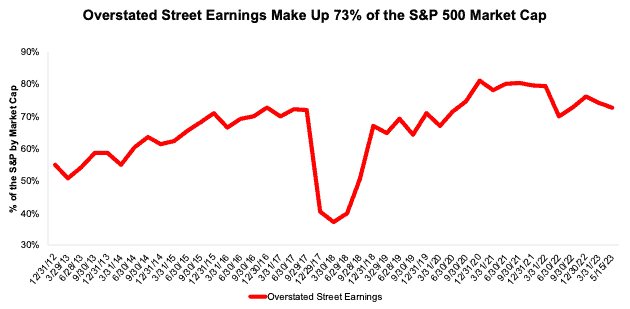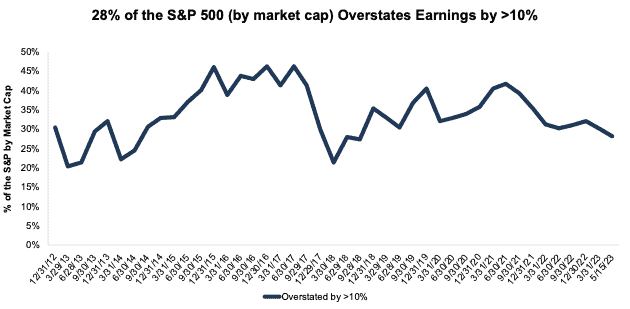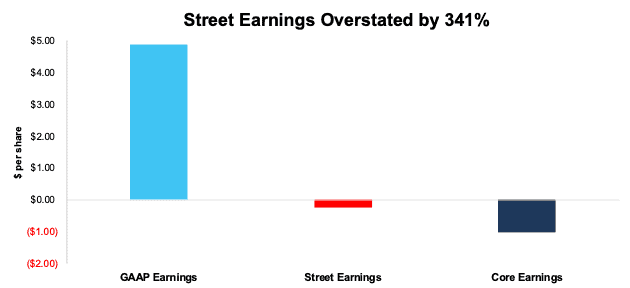Street Earnings, as reflected in Zacks Earnings, are marketed as being adjusted to remove non-recurring items. Our Core Earnings[1] show Street Earnings fail to account for a material amount of unusual items, which distorts investors’ view of profitability across the S&P 500. This report shows:
- the prevalence and magnitude of overstated Street Earnings in the S&P 500
- why Street Earnings (and GAAP earnings) are flawed and not adjusted as promised
- five S&P 500 companies with overstated Street Earnings and a Very Unattractive Stock Rating
Over 190 S&P 500 Companies Overstate EPS by More than 10%
For 347 companies in the S&P 500, or 69%, Street Earnings are higher than Core Earnings[2] for the trailing-twelve-months (TTM) ended 1Q23. In the TTM ended 4Q22, 339 companies overstated their earnings.
When Street Earnings are higher than Core Earnings, they are overstated by an average of 22%, per Figure 1.
Figure 1: Street Earnings Overstated by 22% on Average in TTM Through 1Q23[3]
Sources: New Constructs, LLC and company filings.
The 347 companies with overstated Street Earnings make up 73% of the market cap of the S&P 500 as of 5/15/23, which is down from 74% in 4Q22, measured with TTM data in each quarter.
Figure 2: Overstated Street Earnings as % of Market Cap: 2012 through 5/15/23
Sources: New Constructs, LLC and company filings.
For over a third of the S&P 500 (191 companies), Street Earnings are overstated by more than 10% vs. Core Earnings. These 191 companies make up 28% of the market cap of the S&P 500 as of 5/15/23. See Figure 3.
Figure 3: Overstated Street Earnings by > 10% as % of Market Cap: 2012 through 5/15/23
Sources: New Constructs, LLC and company filings.
The Five Worst Offenders in the S&P 500
Figure 4 shows five S&P 500 stocks with a Very Unattractive Stock Rating and the most overstated Street Earnings (Street Distortion as a % of Street Earnings per share) over the TTM through 1Q23. “Street Distortion” equals the difference between Core Earnings per share and Street Earnings per share. Investors using Street Earnings miss the true profitability, or lack thereof, of these businesses.
Figure 4: S&P 500 Companies with Most Overstated Street Earnings: TTM 1Q23
Sources: New Constructs, LLC and company filings.
*Measured as Street Distortion as a percent of Street EPS.
In the section below, we detail the hidden and reported unusual items that distort GAAP Earnings for MGM Resorts International). All of these unusual items are removed from Core Earnings.
MGM Resorts’ 1Q23 TTM Street Earnings Overstated by $0.78/share
The difference between, or Street Distortion in, MGM Resorts’ Street Earnings (-$0.23/share) and Core Earnings (-$1.01/share) is $0.78/share, or 341% percent of Street Earnings.
MGM Resorts’ GAAP Earnings Distortion is higher at $5.89/share, which indicates that Street Earnings are identifying some non-operating and unusual items. However, given the disconnect between Street and Core Earnings, it’s clear that Street Earnings still miss material adjustments.
Figure 5: Comparing MGM Resorts’ GAAP, Street, and Core Earnings: TTM 1Q23
Sources: New Constructs, LLC and company filings.
Below, we detail the differences between Core Earnings and GAAP Earnings so readers can audit our research. We would be happy to reconcile our Core Earnings with Street Earnings but cannot because we do not have the details on how analysts calculate Street Earnings.
MGM Resorts’ Earnings Distortion Score is Strong Miss and its Stock Rating is Very Unattractive. MGM Resorts receives a Very Unattractive rating largely due to its negative economic earnings, negative return on invested capital (ROIC) of -1%, and the expensive valuation of its stock. Despite trading at $39/share, MGM has an economic book value (EBV), or no-growth value, of -$6/share. Negative ROIC and an expensive valuation land MGM Resorts in our Most Dangerous Stocks Model Portfolio in June as well.
Figure 6 details the differences between MGM Resorts’ Core Earnings and GAAP Earnings.
Figure 6: MGM Resorts’ GAAP Earnings to Core Earnings Reconciliation: TTM 1Q23
Sources: New Constructs, LLC and company filings.
More details:
Total Earnings Distortion of $5.89/share, which equals $2.3 billion, is comprised of the following:
Reported Unusual Gains Pre-Tax, Net = $9.73/per share, which equals $3.9 billion and is comprised of:
- $3.8 billion in gains on property transactions in the TTM based on
- $396 million gain on property transactions in 1Q23
- $1.1 billion gain on sale of the operations of The Mirage in 4Q22
- $12 million gain on property transactions in 3Q22
- $2.3 billion gain on REIT transactions in 2Q22
- $19 million gain on property transactions in 2Q22
- $95 million in “other income in the TTM based on
- $46 million in other income in 1Q23
- $106 million in other income in 4Q22
- -$14 million in other expense in 3Q22
- -$43 million in other expense in 2Q22
- -$30 million in other property transactions expense in the 2022 10-K
Tax Distortion = -$3.76/per share, which equals -$1.5 billion
Reported Unusual Gains After-Tax, Net = -$0.08/per share, which equals -$32 million and is comprised of:
- -$32 million in adjustments related to redeemable noncontrolling interests in the 2022 10-K
Given that the Earnings Distortion listed above is all reported, unknowing investors may assume Street Earnings properly adjust for these items. However, given the $0.78/share Street Distortion in MGM Resorts’ earnings, it’s clear that Core Earnings include a more comprehensive set of unusual items when calculating true profitability.
This article was originally published on June 2, 2023.
Disclosure: David Trainer, Kyle Guske II, and Italo Mendonça receive no compensation to write about any specific stock, style, or theme.
Questions on this report or others? Join our Society of Intelligent Investors and connect with us directly.
[1] The Journal of Financial Economics features the superiority of our Core Earnings in Core Earnings: New Data & Evidence.
[2] Our Core Earnings research is based on the latest audited financial data, which is the calendar 1Q23 10-Q in most cases. Price data as of 5/15/23.
[3] Average overstated % is calculated as Street Distortion, which is the difference between Street Earnings and Core Earnings.






